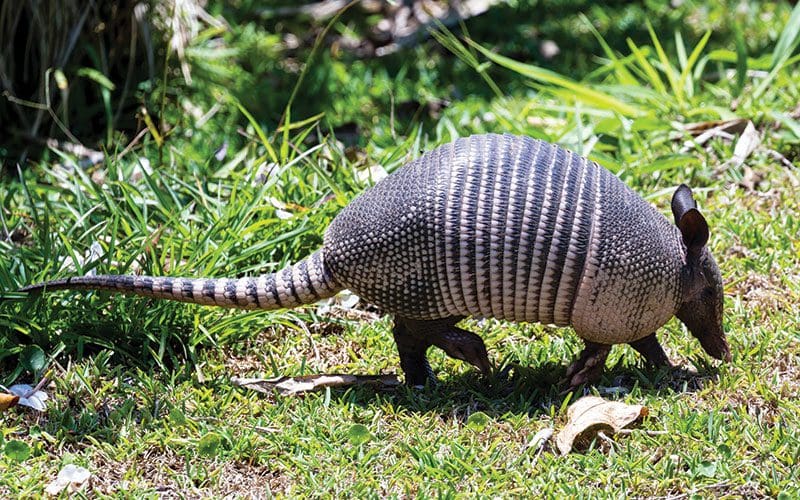
Nine-Banded Armadillo
The nine-banded armadillo is a fascinating medium-sized mammal. It is one of the official state animals of Texas. Its ancestors originated in South America in a wide range of habitats from rainforest to grassland and dry scrub. It was the development of the Isthmus of Panama that allowed its migration north. Currently, it ranges all the way up through Central America and the southern United States and continues to expand its range in both directions.
Historically in the United States, early German settlers lived on the meat of armadillos and referred to them as “panzerschwein’’ (armored pig). They were also called “poor man’s pork” and “Hoover hog” during the Great Depression by those who considered President Hoover responsible for the economic hardships.
It is capable of floating
across rivers by inflating its
intestines or sinking
and running across riverbeds.
While its name — nine-banded armadillo — suggests it should have nine bands, the actual number varies by location. Unlike the South American three-banded armadillo, the nine-banded cannot roll itself into a ball. It does have some amazing escape tactics, however. It is capable of floating across rivers by inflating its intestines or sinking and running across riverbeds. The ability to hold its breath for up to six minutes means it can travel quite a distance underwater to escape predation. If alarmed, it can jump four feet straight up in the air or quickly burrow into the soil, making it almost impossible for predators to extract.
Although it is widely believed that armadillos are shy and therefore most visible during evening or night, we viewed several of these little guys rooting around under the bushes during midday on Costa Rica’s Nicoya Peninsula. We got within six feet taking photos and they didn’t seem bothered by our presence at all, but this is probably due to their very bad eyesight.
This little guy is primarily an insectivore, with the ability to thrust its snout into loose leaf litter and soil for termites, ants, worms and grubs, which it laps up with a long sticky tongue. This aggressive digging poses some threat to the gopher tortoise by disturbing its nests of eggs. Armadillos are considered a pest, and — speaking of eggs — will steal the eggs of poultry and game birds.
Nonetheless, armadillos have an important symbiosis with their environment. While they can cause mild damage to the ground with their burrowing and rooting around, other animals rely on these habits for their own existence. For example, rattlesnakes, pine snakes, skunks, cotton rats and burrowing owls may be found living in abandoned armadillo burrows. The fan-tailed warbler commonly follows armadillos to feast on the insects and other invertebrates they have disrupted.
What Costa Rica offers the nine-banded armadillo in return is the consistently mild to warm climate needed to survive. This is essential due to its very low metabolic rate and cool body temperature without body fat to store heat. Also, Costa Rica’s generally rich soil makes for excellent rooting around and a generous food supply for the armadillo.
Armadillos are prolific, reaching sexual maturity at one year and producing quadruplets every year for the next 12 to 15 years of life expectancy. The babies, however, are born blind and bald, requiring the mother’s protection for the first several months of life, leaving them vulnerable to prey.
And that brings us to predators. Some animals that pose a threat to the armadillo are large wild cats, bobcats, wolves, bears, alligators, crocodiles and large raptors. But, surprisingly, humans, by far, are the leading predator of nine-banded armadillos today. Armadillos are still harvested for their meat and shells, and many thousands get killed on roadways every year. And we mustn’t fail to mention that they are domestically raised in Texas to participate in the small-scale, well-established sport of armadillo racing.
